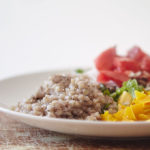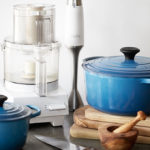
Eat buckwheat to keep your blood moving & your heart healthy
Despite the name, buckwheat bares no relation to wheat. This amazing nutritious and versatile grain is technically a seed related to rhubarb and sorrel, which makes buckwheat an excellent gluten-free grain option. Because it’s a more complete protein akin to quinoa and other grain-like seeds, it can also play an important part in a plant based diet.
Buckwheat has a uniquely earthy flavor probably owed to the myriad minerals and flavonoids (phytonutrients) packed into each granule. A cup of buckwheat contains 4.54 grams of fiber, which will keep you regular, satiated and feeling stable for hours. It’s rich in magnesium, tryptophan, manganese and copper.

In its whole unprocessed form (avoid “puffed” groats), buckwheat is known to help lower the risk of developing cholesterol problems, high blood pressure, diabetes, gallstones and even colon cancer. It’s extremely healthful for people with any cardiovascular or cholesterol related issues, improves blood flow, lowers blood pressure and as a result protects against heart disease.
Cooking Notes
SOAKING GRAINS IS AN EASY AND VITAL STEP FOR GOOD HEALTH
All grains, nuts and seeds contain a series of anti-nutrients which act as natural pesticides, sprouting inhibitors and other essential factors for the health of the plant. Unfortunately when consumed by humans, unlike the multi-chamber stomachs of ruminants, the acids in our guts are not strong enough to brake those chemicals down effectively.
AS A RESULT THE PHYTIC ACID, TANNINS, GLUTEN-RELATED PROTEINS AND ENZYME-INHIBITORS IN UNSOAKED GRAINS WILL:
- bind with essential minerals in the gut, flushing them from your body
- block new mineral absorption
- irritate the gut
- inhibit digestion
- lead to bone loss
- cause allergies
- put stress on the pancreas
Altogether these effects can lead health problems — but can be prevented with one simple step.
During the soaking process the acids in vinegar or lemon juice help to eliminate anti-nutrient compounds while allowing the plant to sprout. The sprouted seed released from dormancy becomes a live food once again. Nuetralizing the seed-preserving compounds allows for the body to stay mineralized while being further fortified with essential minerals (meaning that your body cannot produce them) otherwise locked into the grain. Bio-available vitamin content increases, “tannins, complex-sugars, gluten and other difficult-to-digest substances are partially broken down into simpler components that are more readily available for absorption.” (source)
As you can see, this process is non-negotiable if you’d like to improve or maintain good health. The bonus is that your cooking times will be drastically reduced. By about half for most grains!

I’ll admit that I don’t soak and sprout my nuts and seeds. You really need a dehydrator for that, and due to considerations of space, time and energy, I’ve decided to let that slide. My diet contains a very small fraction of nuts and seeds compared to how much, and how often, grains play a role in my diet. This feels good to me–and it ends up saving me time!
TIPS FOR GOOD HEALTH AND EASE
- Soak for a minimum of 6 hours, but you can leave the grains in the same water for about 24 hours.
- If you’re not ready to cook when 24 hours is up, simply refill with fresh water and vinegar.
- Soak in a dark warm place, like a cupboard or oven (while turned off).
- Pour off the soaking liquid before cooking and rinse the grains at least once.
- For extra pure grains: pour off soaking liquid, add fresh water, stir well and let any bubbles or foam rise, pour water off. Repeat until all the impurities have been released and the water is clear.
- Soaked grains absorb water, decreasing cooking time and grain to water ratios. Once you’ve made soaked grains a few times you’ll get a better sense of water ratios and will know when to add less, or more.
- Store dry grains in a glass container with a tight lid, away from direct sunlight to prevent rancidity of the fragile oils contained in the seeds.
Mix in this Green Dressing for a tantalizing savory side dish, or eat it sweet like oatmeal.





